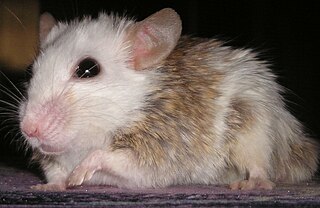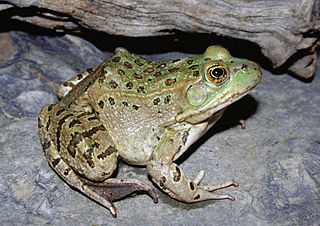A Ramsar site is a wetland site designated to be of international importance under the Ramsar Convention. The Convention on Wetlands, known as the Ramsar Convention, is an intergovernmental environmental treaty established in 1971 by UNESCO, which came into force in 1975. It provides for national action and international cooperation regarding the conservation of wetlands, and wise sustainable use of their resources. Ramsar identifies wetlands of international importance, especially those providing waterfowl habitat.
Myomyscus is a genus of rodent which occurs in Africa. Species in this genus are often placed in the genus Myomys Thomas, 1915, but the type specimen for Myomys is a Mastomys. Other species that had been previously assigned to Myomys are now considered to belong to the genera Praomys and Stenocephalemys.
The Awash multimammate mouse or Awash mastomys is a species of rodent in the family Muridae found only in Ethiopia. Phylogentically the Awash multimammate mouse is the sister taxon of the Natal multimammate mouse, a species found almost everywhere in Africa south of the Sahara and considered a serious agricultural pest throughout its range.

Mastomys is a genus of rodent in the family Muridae endemic to Africa. It contains these species:

The southern multimammate mouse or southern African mastomys is a species of rodent in the family Muridae which is endemic to southern Africa. It is called a multimammate mouse because it can have 8 to 12 pairs of mammae, in comparison other mouse species only have 5 pairs.
The Guinea multimammate mouse is a species of rodent in the family Muridae found in Benin, Burkina Faso, Burundi, Cameroon, the Central African Republic, Chad, the Republic of the Congo, the Democratic Republic of the Congo, Ivory Coast, Ethiopia, Gambia, Ghana, Guinea, Guinea-Bissau, Kenya, Liberia, Mali, Mauritania, Morocco, Niger, Nigeria, Rwanda, Senegal, Sierra Leone, Sudan, Togo, and Uganda. Its natural habitats are subtropical or tropical dry forests, dry savanna, moist savanna, subtropical or tropical dry shrubland, subtropical or tropical moist shrubland, arable land, rural gardens, urban areas, and irrigated land. They weigh between 12 and 105 grams.
Hubert's multimammate mouse, or Hubert's mastomys is a species of rodents in the family Muridae found in Burkina Faso, Gambia, Mali, Mauritania, Nigeria, and Senegal, and possibly Guinea, Guinea-Bissau, and Niger. Its natural habitats are dry savanna, subtropical or tropical seasonally wet or flooded lowland grassland, arable land, rural gardens, urban areas, irrigated land, and seasonally flooded agricultural land.

The Natal multimammate mouse is a species of rodent in the family Muridae. It is also known as the Natal multimammate rat, the common African rat, or the African soft-furred mouse.
The dwarf multimammate mouse is a species of rodent in the family Muridae found in Kenya, Rwanda, and Tanzania. Its natural habitat savanna.
Shortridge's multimammate mouse is a rodent species in the family Muridae. It is native to Angola, Botswana and Namibia. Its natural habitats are moist savanna, subtropical or tropical seasonally wet or flooded lowland grassland, and swamps.
Setzer's pygmy mouse is a species of rodent in the family Muridae. It is found in Botswana, Namibia, and Zambia. Its natural habitats are dry savanna, rivers, freshwater lakes, and intermittent freshwater lakes.
The thin sand rat or lesser sand rat is a species of rodent in the family Muridae. It has also been previously named the pale sand rat based on work published by Oldfield Thomas in 1925. It is found in Algeria, Libya, and Tunisia, and its natural habitats are subtropical or tropical dry shrubland and intermittent salt lakes. The thin sand rat was previously classified as a subspecies of the fat sand rat. However, morphological differences in size and coat color between the two animals, along with recent molecular evidence suggest that they are different species. The thin sand rat may be a natural reservoir for the disease leishmaniasis.
The tiny fat mouse is a species of rodent in the family Nesomyidae. It is found in Angola, Botswana, Ethiopia, Kenya, Mozambique, Namibia, South Sudan, Tanzania, Uganda, Zambia, and Zimbabwe. Its natural habitats are subtropical or tropical dry shrubland and subtropical or tropical dry lowland grassland.

The Chiricahua leopard frog is a species of frog in the family Ranidae, the true frogs. It is native to Mexico and the United States. Its natural habitats are temperate forests, rivers, intermittent rivers, swamps, freshwater lakes, intermittent freshwater lakes, freshwater marshes, intermittent freshwater marshes, freshwater springs, ponds, and open excavations. It is threatened by habitat loss and chytrid fungus to such an extent that it has been eliminated from 80% of its former habitat. The Phoenix Zoo, Arizona's Department of Game and Fish, and the USFWS are trying to mitigate threats through captive breeding and reintroduction efforts.

The Congo clawless otter, also known as the Cameroon clawless otter, is a species of clawless otter in the family Mustelidae. It was formerly recognised as a subspecies of the African clawless otter.

Laelaps is a genus of common parasitic mites in the family Laelapidae. Species, with their hosts, include:





